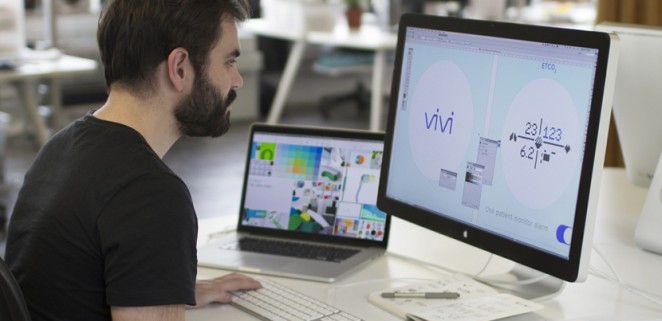With all the technological advancements being thrust upon the world of entertainment, it's only natural (and fair) that these advancements are also being used to benefit us in ways beyond keeping ourselves occupied in the hours between sleep and work. To this end, experience design studio Method has developed the “Vivi” alongside product development and engineering company GlobalLogic, for Bay Innovations, a start-up initially set up by a pair of professional anaesthetists. Vivi is a head-mounted display (HMD) product tailored for surgeons, nurses and paramedics, which allows them to more easily and effectively monitor a patient’s vital signs while they are working.
Experience design consultancy Method has developed the “Vivi” alongside product development and engineering company GlobalLogic, for Bay Innovations
The plan is for Bay Innovations to take the device to market after a period of user testing and clinical testing, with the final product potentially revolutionising the work of anaesthetists, nurses and paramedics by making the live-saving job of surgery that much easier. Method, who were responsible for the industrial design, the interface and the user experience, have designed a device that gives health professionals access to the patient’s heart rate, blood pressure and oxygen levels, directly within their field of view in a clear, unobtrusive HMD.

The major benefit is that user's will be able to respond more quickly to the task in hand, and focus more attention on the surgery, procedure or examination, while giving full attention to the patient. Method lead interaction designer Neil Usher, said: “In a clinical environment monitoring equipment is perfectly reliable but it’s not always in a clinician’s line of sight and can sometimes be obscured by team members; a clinician can’t give all their attention to a patient if they’re constantly referring to equipment.”
Vivi is a head-mounted display (HMD) product tailored for surgeons, nurses and paramedics, which allows them to more easily monitor a patient’s vital signs
Method originally planned to use an existing device as a basis for their design, but found that the likes of Google Glass or the Vuzix M100 were too generalised for specific applications, so sought to find a user centred solution with no excessive features. Simply put, a jack-of-all-trades just wasn't going to cut it. The device had to meet the demands of a clinical environment, integrate with existing monitoring equipment, and prove to be robust, hygienic and physically unobtrusive. It also needed to manage attention, but without being unnecessarily distracting, and work reliably for hours on end without being charged.

Method took a holistic design approach to balance user needs with technology constraints, business objectives and a strong identity. A discovery phase launched the project combining user interviews, clinical studies and extensive research. Challenges, opportunities and requirements were identified and through prototyping, designs were iterated. A route emerged and optics, electronics and firmware were developed – along with a name, identity and route to market.
The Vivi works using a secure Bluetooth connection to collect patient data and integrate it into the system and is controlled through an accompanying app
The Vivi works using a secure Bluetooth connection to collect patient data and integrate it into the system and is controlled through an accompanying app, which can be programmed by each individual user to meet their own requirements. The product has been designed to be lighter, cheaper, more reliable and with a longer battery life than any other HMD on the market, and the triangular form of the product and the ball socket design is design registered and patented.

Whilst it has primarily been developed for the medical industry of course, Method has also helped Bay Innovations look at other ways it might market the product to different industries. For example, it could work for light industry, security, retail, or for anyone looking for simple, cheap and robust HMDs. The company has already made a cycling version with simple GPS and navigation, so the possibilities are only just beginning to be explored. Personally I see applications in everything from industrial factory work to design work, but for now, I can think of no better place for this inspiring technology than in the hands of the world's top medical professionals!

Benjamin Hiorns is a freelance writer and struggling musician from Kidderminster in the UK.






